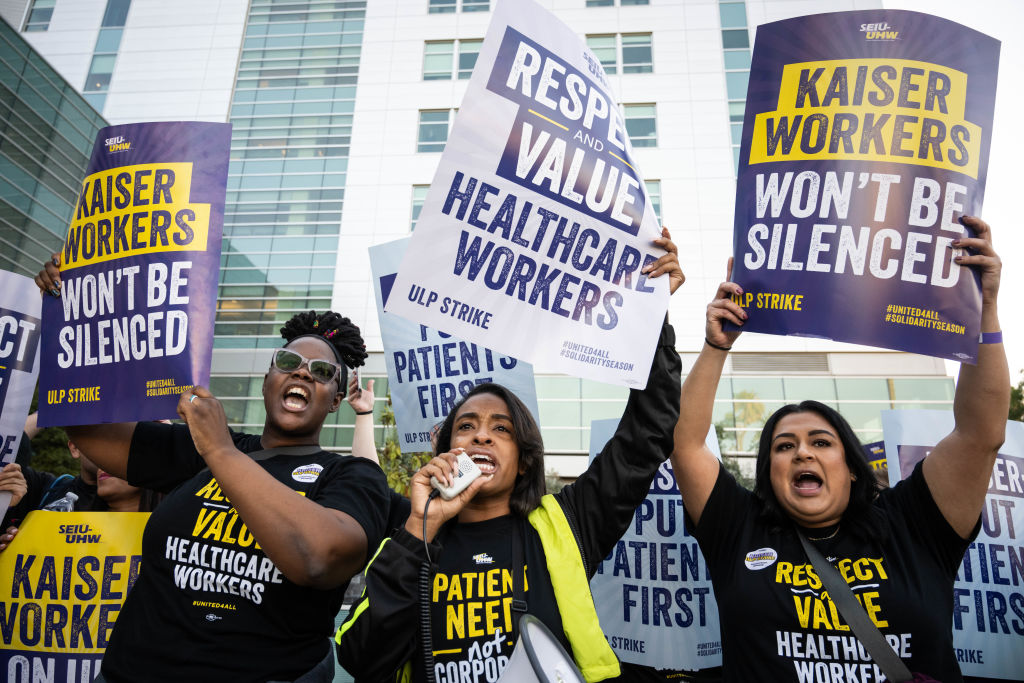
More than 75,000 unionized Kaiser Permanente well being care employees walked off the job on Oct. Four within the largest well being care {industry} strike in U.S. historical past. Picketing started early this morning in Washington, D.C., and Virginia, with workers following swimsuit at Kaiser services in Colorado, California, Oregon, and Washington after a fruitless last try in a single day to settle a contract with chief executives on the non-profit well being system. The strike will final a most of three days earlier than the coalition will ship members again to work amid additional negotiation, although D.C. employees are putting for someday solely.
The eight unions concerned within the strike cowl 40% of Kaiser Permanente’s workforce, lots of whom have expressed considerations with inadequate staffing ranges they are saying have endured because the pandemic, inflicting lapses in each affected person care and the supply of truthful labor practices. Although medical doctors, some nurses, and different employees not lined by the Coalition of Kaiser Permanente Unions will likely be working all through the strike in an effort to preserve hospitals and emergency departments open, the group has requested for persistence from the almost 13 million Individuals it covers, who can anticipate excessive wait occasions and rescheduled non-urgent procedures and appointments.
Learn Extra: American Well being Care Faces a Staffing Disaster And It is Affecting Care
“Kaiser used to carry itself out as the most effective place to get care and the most effective place to work, however it’s now failing at each. Kaiser can and should do higher,” Linda Bridges, president of the OPEIU Native 2 union that represents 8,000 Mid-Atlantic Kaiser employees, mentioned shortly earlier than the employees’ current contract expired on Sep. 30.
The ensuing strike is the most recent to happen as tensions over labor rights ratchet up in quite a few U.S. industries. In line with the U.S. Bureau of Labor Statistics, 2022 noticed a complete of 120,600 employees concerned in 23 main work stoppages. Together with a United Auto Staff walkout that started in September, the Kaiser strike brings the 2023 complete to greater than 400,000 with almost three months left within the 12 months. The Kaiser Permanente strike can also be a mirrored image of the widespread downside understaffing has change into within the U.S. well being care {industry}. Lots of the identical considerations had been expressed by the 7,000 nurses at two New York Metropolis hospitals who protested for 3 days in January. Due to unions’ dedication to prioritizing affected person care, strikes within the well being care {industry} are topic to particular necessities that may make them tougher to execute, together with offering organizations with 10 days discover.
Extra From TIME
Throughout COVID, “there was type of a rupture within the relationship between well being care employees and their employers,” says Patricia Pittman, director of the Well being Workforce Analysis Heart at George Washington College’s Milken Institute Faculty of Public Well being. “There’s a way among the many well being care workforce, that, frankly, no one cared about their security.”
What’s At Stake
The putting employees make up almost all parts of affected person care at Kaiser clinics, and embrace emergency division technicians, pharmacists, housekeepers, and a whole lot of different positions. “These are the individuals who you are going to see from the second you stroll as much as the entrance desk to the nurses [who] are at your bedside,” says Renee Saldana, a spokesperson for California-based SEIU-UHW, the biggest of the putting unions.
In California, the place Kaiser is the only largest supplier of well being care, a Could survey of 33,000 employees throughout well being methods carried out by a state well being care justice union discovered {that a} majority of respondents had witnessed delayed or denied affected person care as a result of staffing shortages. Seventy-four p.c particularly cited not having sufficient time to take care of sufferers correctly, whereas 83% reported understaffing of their departments.
“Management is up towards the wall already, as a result of so many individuals are quitting,” says Pittman. The ensuing impacts are current at many non-Kaiser hospitals, she provides: “We see it with the CDC reporting this big spike in hospital-acquired infections and different affected person security episodes.”
The union coalition cites executives’ unwillingness to spend money on staffing as a key trigger of those points. The coalition is demanding not solely elevated hiring past the 10,000 new rent objective for 2023 established earlier this week by Kaiser, but additionally greater pay and higher coaching, each of which they are saying might assist stop excessive turnover within the face of industry-wide burnout and cost-of-living crises in key states the place Kaiser operates. The at present proposed 4% most annual wage improve in Kaiser’s contracts is inadequate, the coalition says.
Strikers additionally oppose a proposed change by Kaiser leaders that may make it simpler for jobs to be subcontracted and outsourced to impartial well being care corporations, a apply that coalition representatives say prioritizes lower-paid work on the threat of office stability.
The strike might additionally portend related motion in different U.S. well being methods, says Pittman, on condition that Kaiser had for a few years been “held up” as a mannequin for labor rights and wage stability within the {industry}, due partly to forward-looking negotiations within the late ‘90s.
“It is significantly surprising that this could possibly be occurring at Kaiser Permanente,” she says, “and type of doesn’t bode nicely for the remainder of the healthcare organizations within the nation.”
Extra Should-Reads From TIME



